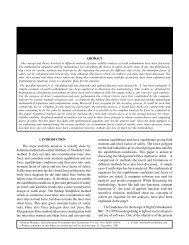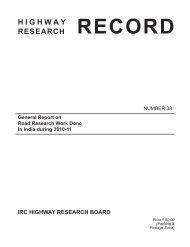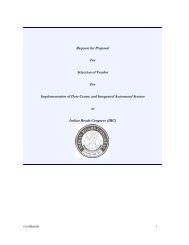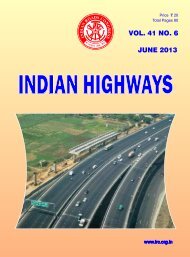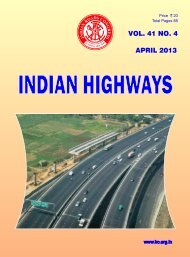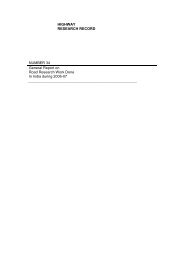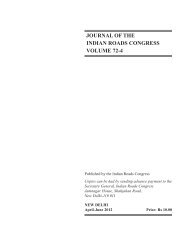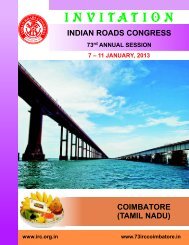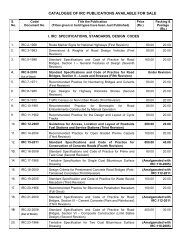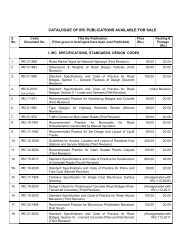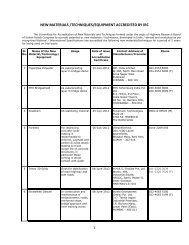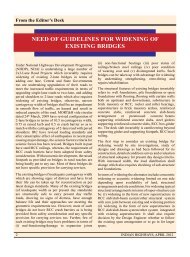Highway Research Record No. 39 - Indian Roads Congress
Highway Research Record No. 39 - Indian Roads Congress
Highway Research Record No. 39 - Indian Roads Congress
You also want an ePaper? Increase the reach of your titles
YUMPU automatically turns print PDFs into web optimized ePapers that Google loves.
Significance/ Utilisation potential<br />
Based on laboratory studies, it is concluded that the<br />
copper slag mixed with locally available pond ash by<br />
50 per cent was found suitable as a road construction<br />
material, especially for embankment construction.<br />
Further information/Copy of report can be obtained<br />
from<br />
address: The Head, Geotechnical Engg. Division,<br />
CSIR- Central Road <strong>Research</strong> Institute, New Delhi -<br />
110025, Mobile: 9868858380, phone: 26832173, Fax:<br />
011-26845943, e-mail ID: vittal.crri@gmail.com<br />
B. CoMpleteD proJeCtS<br />
1. Engineering of Structures against Natural and<br />
Other Disasters<br />
Keywords: Cyclone disaster, Differential global<br />
Positioning System, steel pedestals, lanslides<br />
I.<br />
II.<br />
Date of Start: July 2007<br />
Central Road <strong>Research</strong> Institute, New Delhi(<br />
R )<br />
Structural Engineering <strong>Research</strong> Centre (C)<br />
present Status and progress<br />
Status: Continued<br />
Year of Last Report: 2011<br />
Further Findings/ Supporting Data<br />
This project has been taken up as a network project<br />
coordinated by SERC, Chennai. Preparation of<br />
Guidelines for Cyclone prone areas and studies on two<br />
large landslide affected areas were carried out under<br />
this project. Under the second project, two landslides<br />
namely Patalganga and Kaliasaur landslides have<br />
been selected for detailed investigations under this<br />
project.<br />
Work done on Kaliasaur landslide:<br />
1. Base Map Preparation: A total 231.49 Ha area<br />
was covered for the topographical survey with<br />
scale of 1:500. The topographic base map which<br />
was produced with the help of high precision total<br />
station and the DGPS was used to develop a<br />
Digital terrain model and its derivatives maps such<br />
as slope and aspects. The DTM and its derivatives<br />
give opportunity of logical thinking about the<br />
possible influence and activities on the basis of<br />
visual observation on the ground.<br />
ROAD RESEARCH IN INDIA 2011-12 <strong>39</strong><br />
2.<br />
3.<br />
Geomorphological Assessment:<br />
Geomorphological studies of the area have been<br />
carried out on the base map of the 1:500 scale.<br />
The morphology of slide has changed regularly<br />
since the slide first appeared. Repeated sliding<br />
of minor magnitude have been occurring from<br />
the main scarp of the slide making the slide<br />
retrogressively moved because the surface of<br />
rupture was extending in the direction opposite the<br />
movement of the displaced material. However, at a<br />
later date the surface of rupture started extending<br />
at the lateral margin as well widening the slide<br />
making it advancing in nature. The cliff, the steep<br />
rupture surface of the top has got enlarged by 40m<br />
since 1984. In 2010 alone it has got enlarged by<br />
20 m during one event of sliding. The cliff between<br />
the crown and displaced material become irregular<br />
because of the numerous gullies. There are many<br />
cracks above the crown part. Below the main scarp<br />
there are a few minor scarp developed, indicating<br />
successive sliding.<br />
Investigating the Role of Geology in Slope<br />
Instability: Detailed geological map of the area<br />
was prepared to find out the role played by<br />
lithology and structures to affect the slope stability.<br />
The independent geology and structural mapping<br />
revealed the fact that structures are formed by<br />
tectonic deformations in past geological times. The<br />
detailed study of major and minor structures was<br />
carried out with an intention of figuring out their role<br />
in inducing instability and causing the slope failures<br />
in the area. In the area of study it has been observed<br />
that contacts between two litho-units (e.g. pink and<br />
white quartzite) are often a fault, i.e. their contact<br />
surface is actually faulted. Prominent foliation of<br />
the area shows that the strata are folded synclinally<br />
and anticlinally. Wedge failure is the most common<br />
mode of failure in highly jointed quartzite rock in<br />
this area.<br />
In a similar manner, Micro-Zonation Analysis Based<br />
on Rock Mass Rating (RMR) and Slope Mass Rating<br />
(SMR), Kinematic Slope Stability Analysis, Microhazard<br />
evaluation has been carried out for this slide.<br />
The landslide activity reactivated during Sep-Oct 2010<br />
and NH 58 had to be closed to traffic and vehicles had to<br />
take a longer detour. CRRI has carried out estimation of<br />
indirect landslide losses due to reactivation of Kaliasaur<br />
landslide using unit cost estimation method.<br />
Detour cost = (Extra operating costs in detouring +<br />
Extra fuel used * Fuel price) * Number of travelers<br />
affected.<br />
The estimation was based on traffic affected due to<br />
detouring due to blockage of National <strong>Highway</strong>–58.



